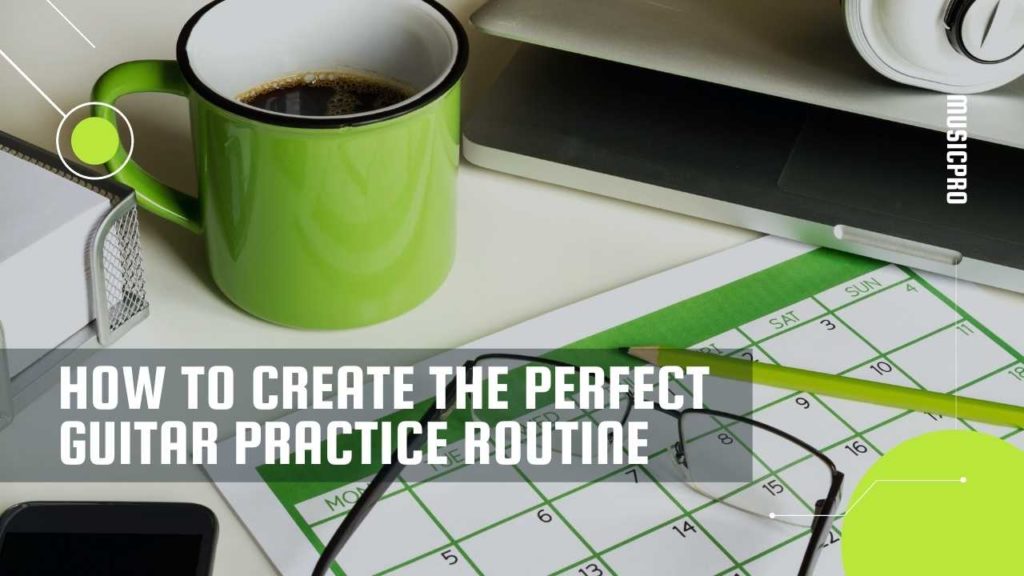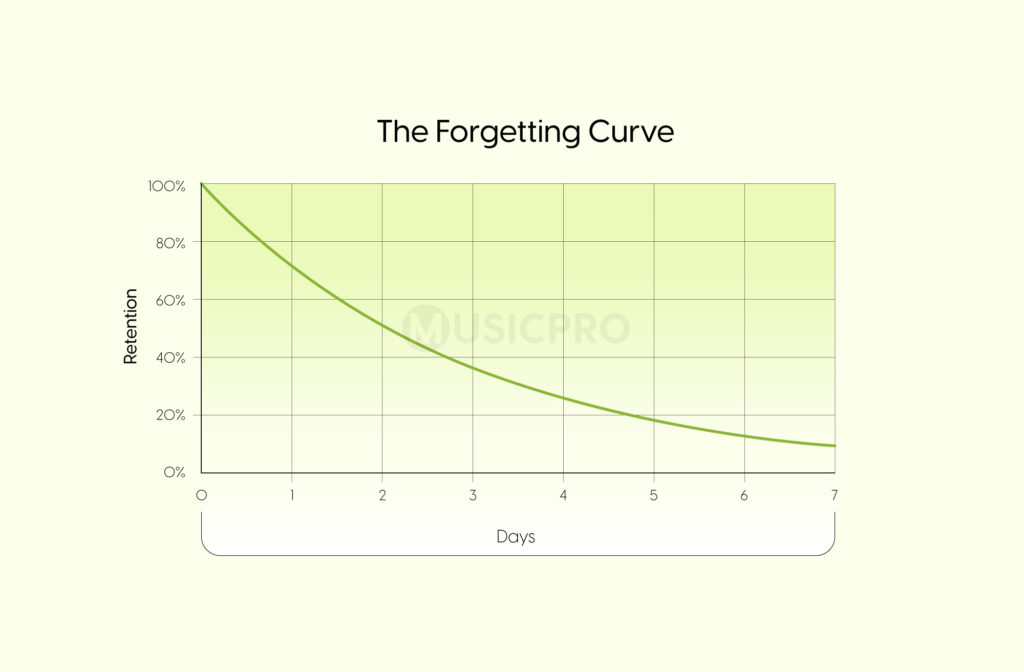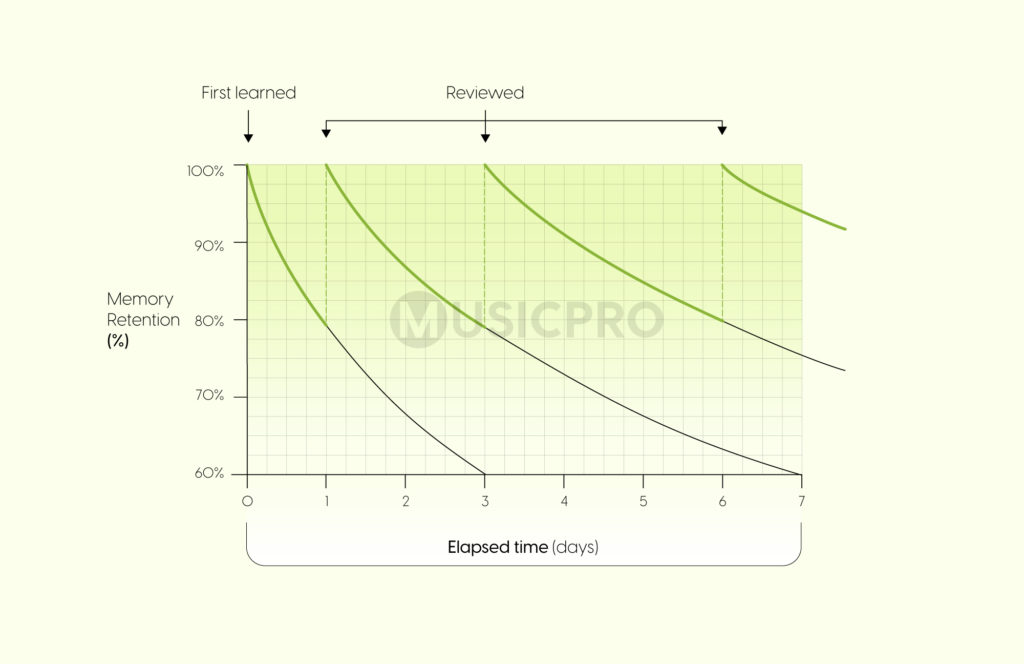
Let’s face it…
Practicing is hard.
You have to work hard both physically and mentally if you are doing it right.
And often the simple difference between failing and succeeding is in how you plan your guitar practice routine..
But developing and organizing an effective guitar practice routine can feel a bit overwhelming.
What should you practice, how long should you practice for, what tools do you need?
Your daily practice schedule and tasks need to be organized to make sure you focus on the important things
This is why so many guitar players put it off – they just want to play guitar.
So they just pick and choose random ideas, to practice and play
And next thing you know, they’re stuck in a rut.
But don’t fret…
Here are some essential tips for developing and organizing your own perfect guitar practice routine, that is both effective and fun!
Let’s get started!
How do I create an effective practice routine for guitar?
Guitar players are notorious for playing what they already know and try to pass it off as a guitar practice routine.
By making a solid practice plan, you’ll ensure you stay on track and avoid falling into this common trap.
Guitar players often get bored of what they are practicing. So it is also important to know what you WANT to play.
This keeps your practice sessions fun and engaging.
But before we start to plan your guitar practice routine, let’s think about what you want to do as a guitar player.
How should I structure my guitar practice routine?
Of course are many ways you can structure your guitar practice sessions. I’m sure every guitar teacher you ask will give you a different answer.
Our focus at MusicPro.Academy is on teaching you how to make steady and measurable progress.
For that, we rely on a framework that has helped grow companies by quantum leaps. (the same goal-setting approach that has aided developing companies like Intel and Google).
It’s called OKR and I’ll show you how you can apply it to your guitar practice routine.
OKR is a popular goal-setting technique.
OKRs have been used by companies since the 1970s. In business, they are a tool to help guide decisions and set goals. OKRs were popularized by Andy Grove (CEO of Intel,) and John Doerr. (Google, LinkedIn, Uber, Twitter, Dropbox)
When applied to music, OKRs help players develop a clear idea of objectives and achieve them.
The framework helps players outline an effective guitar practice routine by showing them how to achieve long-term goals in a short time. You often see results in weeks and not months.
The OKR formula is to set an objective, which is what you want to achieve, and key results, which are how you’re going to do it.
This way, you don’t just think about what you want to do, you also think about how you will know if it’s done.
What Exactly Is An Objective?
Think of an objective as something you can’t measure.
It provides direction, and answers the question of “What?”
- What Music Do I Want To Play?
- What Do I Want To Do as Guitar Player?
The following are the characteristics of Objectives:
- directed,
- impactful and powerful,
- easy to understand
- inspirational
Example:
You play the guitar and you like to play rock music. But you feel like you aren’t getting any better at playing guitar when you practice.
You can play some of your favorite songs, and even do some amazing solos by other players. But when it comes to creating your own music and ideas, you get stuck.
Objective:
I want to record a solo for an original song that is both melodic and has some technical flair.
Use Key Results To Stay On Track And Meet Your Objectives
A Key Result is a specific outcome and it requires specific numbers or figures.
They must be measurable.
“It’s not a Key Result unless it has a number,” as Marissa Mayer, the CEO of Yahoo, once put it.
The goal of Key Results is to help you figure out what you need to do to reach your goal.
When you apply the concept to your guitar practice routine, you use them as milestones.
They answer the question “How?”:
- “How do I know when I get there?”
- “How am I going to do that?”
The qualities of Key Results state that they should include the following:
- measurable
- specific
- have a deadline
So rather than telling yourself
“Today I want to learn a few chords” or “I feel like doing some arpeggio practice”
Be specific, pick key results for your guitar practice routine that you can measure, and give yourself a deadline.
Example:
Let’s continue our Objective:
“I’d want to record a solo for an original song that is both melodic and has some technical flair.”
You need to think about what you’ll use to check how well you did when you’re learning something new.
Key Results:
- Play clean 16th notes 10% faster than the song tempo
- Learn 1 new melodic “restriction” concept to add new stylistic interest to my playing
- Learn one new guitar technique that I have never before used in a solo
- Try 1 new scale source you’ve never used that would work over this chord progression.
What should I focus on in my own practice Sessions?
Now that you’ve set your goals and how you’ll measure progress, it’s time to start planning what things you need to add to your guitar practice routine.
You can add these actions or plans to your daily or weekly practice schedule.
These are the activities and exercises you’ll do when you sit down to play guitar.
They answer the question “How will I achieve this key result?”
Break your practice routine into smaller chunks so you can focus on the parts that need the most work.
The following are the characteristics of Initiatives:
- measurable
- specific
- controllable
- have a deadline
Examples:
Let’s keep expanding on our Objective:
I want to create a solo for an original song that is both melodic and has a bit of impressive technical flash
Let’s think of something we could do in our guitar practice routine every day to help us accomplish our goals.
For example:
Initiatives
- Initiative 1: Exercise – Practice 16th notes and increase 1-2 BPM daily
- Initiative 2: Exercise – Practice adding 1 chromatic approach tone from below to a pentatonic sequence
- Initiative 3: Exercise – Practice adding a slide as an articulation before, inside, and after a pentatonic sequence
- Initiative 4: Exercise – Create 4 recordings applying the techniques over a backing track using the same chord progression.
How Do I Create The Best Guitar Practice Schedule?
Now that you know your objective, key result, and what initiatives you need to take, how do you schedule it?
How can you organize your guitar practice routine so that it is efficient and helps you achieve your goals?
It is common for guitar players to start practicing well, but then they get bored of it and stop.
Often, what starts as a good practice routine quickly becomes a bad practice routine.
But how do you learn what you need to know and also avoid repeating things?
There are many ways to do this, and “spaced repetition” is one of them. We have seen great results with it.
Before we get into what “spaced repetition” means, let’s take a look at why we need it in the first place.
The Forgetting Curve
In the 1800s, Hermann Ebbinghaus, a German psychologist researched how people remember things.
He did an experiment using non-sense syllables and discovered “The Forgetting Curve Theory.”
Ebbinghaus found that after you learn new information, you remember half of it after one hour.
Worse, you might have forgotten up to two-thirds of that knowledge by the following day.
Even though the original study was done so long ago, recent experiments still support this theory
Here’s how The Forgetting Curve looks on a graph…

So How Do I Overcome The Forgetting Curve To Create An Effective Guitar Practice Routine?
Luckily, Ebbinghaus found that if you review new information at key moments, you can reduce the rate at which you forget it.
This is the “spaced repetition” we were talking about before.
It can be a powerful tool when learning and practicing guitar.
The idea behind spaced repetition is to leave some time to allow your brain to forget some of what you learned.
So the next time you try to recall the information, the process is slightly mentally taxing.
The more that your brain works during practice, the better chance you have of remembering.
So, even though our memory fades, if we review the material at specific times, we can improve our recall.
You review only when your ability to recall has slipped but hasn’t fallen so low that you’re starting over.

Reviewing and refreshing specific exercises helps you stay ahead of the Forgetting Curve.
Although the “forgetting” starts again after each review session, it’s slower each time.
That’s why each new curve shown in figure 2 is shallower than the last.
The gaps between your review sessions can also become longer as time goes on.
If you want to better remember what you work on, you can space out the repetitions by a day, three days, then a week.
There are different opinions about what the best length is for the spacing. You can learn what works best for you through time and practice.
Make sure with each repetition, you use less and less help.
If you start a new exercise with a diagram or sheet music/tab, when you review, try to remember without it.
When you use charts and drawings, your review becomes a passive exercise. And then your practice time isn’t as effective.
It is better for you to test yourself one time than repeating the same passage four times.
Daily Guitar Practice Session Breakdown
What you put into your daily guitar practice routine matters a great deal.
A spaced repetition schedule might be as simple as writing down a review time for every exercise.
A different approach is to make a spreadsheet for each result that you want.
Put the exercises into lists under each result, and create a schedule that way.
You can create a daily guitar practice routine that focuses on things like:
- Warm Up
- Music Theory
- Chord Exercises
- Ear Training
- Alternate Picking technique
- Playing over different chord progressions using a backing track.
Maybe one of your goals is to learn new chords
Another might be to play fast.
Or maybe you just want to get better at using chord tones.
Some guitarists find it hard to know what skills they need to learn and how to find exercises that will help them.
Practice smarter, not harder
Instead of you having to do all the work on spreadsheets and planning a guitar practice routine, we’ve already done it for you.
Not only do we have a full course on how to develop your own perfect guitar practice routine…
We’re also developing an AI-assisted Guitar Practice Planner to help you manage your guitar practice routine.
Think of it as your own personal guitar practice routine generator.
It helps you set goals and figure out what to do every day. You can use it to track your progress, too.
This practice planner will help schedule your exercises. This will make you focus on what you need to learn when you need it.
Our Guitar Practice Planner App helps you get the most out of your guitar practice routine.
Use it to keep track of all your exercises and stay motivated.
Join one of our courses today to be first in line to try it when it’s released
You’ll see what a difference the perfect guitar practice routine can make in your playing!
